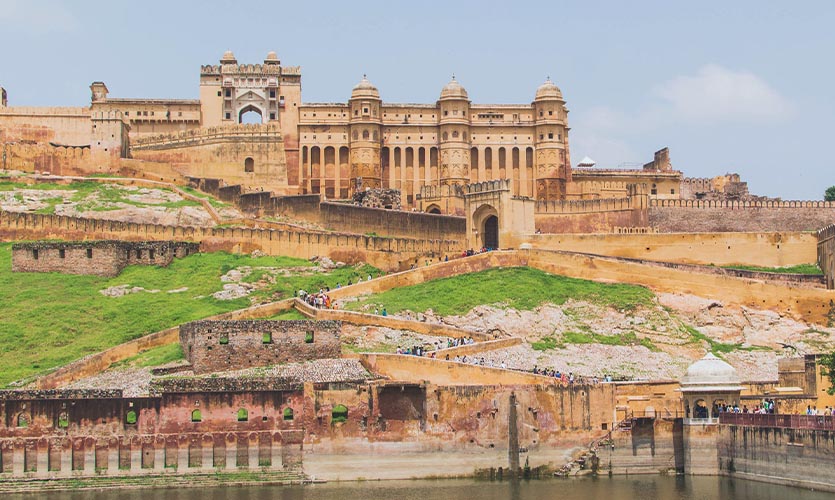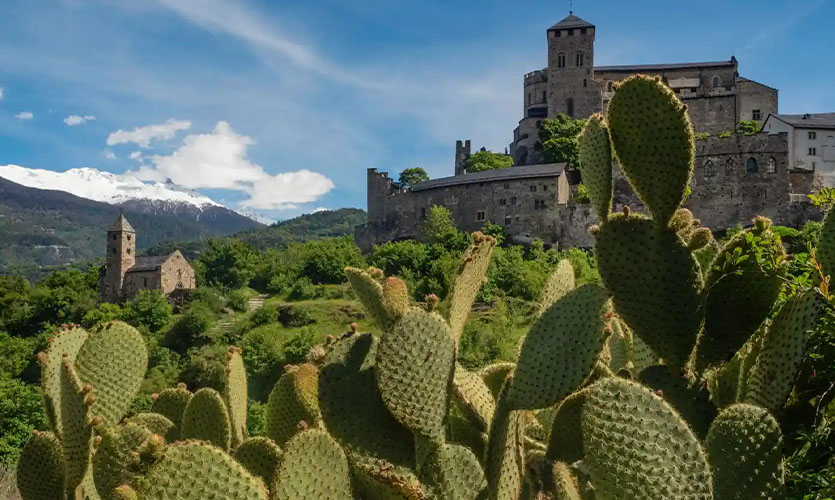The Amer Fort, a magnanimous palace made of red sandstone and marble, sits tall overlooking the Maota Lake on Cheel ka Teela.
Originally built by Raja Man Singh in 1592, the fort exudes the royalty of Rajputs and their ties with the Mughals.
History has repeated tales of romance between Jodha and Akbar, however, it is lesser known that Akbar’s ties with Jodha’s brother, Man Singh I, actually cemented ties between the two empires, and are credited with the construction of a part of Amer Fort.
The Jewel of Jaipur

Amer Fort, also known as Amber Fort (derived from Ambekishwar), took about 100 years to be built under succeeding emperors Raja Jai Singh I, and Jaipur’s founder Sawai Jai Singh II. Surrounded by the rugged Aravalli Hills and built on four levels, the fort has Suraj Pol at the opening, which faces the sun in the east. The gate takes you to the public courtyard from where the cavalry used to enter on elephants after their battles, march for the maharajas, and celebrate their victories. The hall was supported by 27 glistening marble pillars, each of which had an elephant-shaped capital erected on it.
As you walk further into the palace, you are met with the sight of a tall and intricate two-storey Ganesh Pol, which was adorned with bewitching motleys and sculptures. The gate opens to royal quarters or the Diwan-i-Khas, constructed during the reign of Mirza Raja Jai Singh, and overlooks the refreshing and decorated Mughal Gardens.
It is almost impossible to not be under the spell cast by the scintillating beauty of the thousands of glittering glasses in the Sheesh Mahal, constructed by Raja Man Singh. The mirror mosaics would look like a ‘glittering jewel box in flickering candlelight’, and burst into vibrant colours when the queens walked the passages in their beautiful sarees and ghagra cholis.
The fourth courtyard, the Baradari pavilion, was surrounded by 12 rooms for the 12 wives of Raja Man Singh. The rooms were embellished with frescoes and coloured tiles. In the present day, the corridor lights up every night, which is bound to leave you awestruck.
Every corridor of the fort has a different story to tell. This is the story of Amer’s Raja Man Singh and Akbar, which resembles the beauty of the Amer palace.
Akbar’s Marriage Alliances Changed The Game For Rajputs
The beautiful palace withstood many a battle of dynasties and saw different Rajput rulers claim the throne. However, things took a turn with the advent of Mughal emperors and their quest for power in Rajasthan. The Rajputs lost their hold over their reign following their defeat to Babur in the Battle of Kanwar, but in 1562, tables turned when a strong alliance between the Mughals and Rajputs emerged owing to the matrimonial relations between the kingdom of Amer and Akbar.
Being a pragmatic ruler, Akbar was quick to recognise the Rajputs’ significance to the non-Muslim population of his realm. Early in his rule, Akbar realised that because the Rajputs were a bold and fierce clan, their friendship and cooperation would be advantageous to his kingdom in the long term. He subsequently decided to approach the Rajputs with a conciliation plan.
Raja Bharmal, the king of Amber, was the first to develop friendly ties with Akbar. Harkha Bai (also known as Jodha Bai), the younger daughter of Bharmal, was wed to the Mughal king. Similarly, Akbar wed Rajput princesses from Jaisalmer and Bikaner. Later, Prince Salim, his son, wed Raja Bhagwandas’s daughter.
Akbar’s Nauratan: Mirza Raja
Rajputs were widely accepted into Akbar’s princely service. During the emergence of Islamic rule in India, Muslims were the only ones eligible for prominent positions in the royal service. Akbar broke free of the custom and gave Rajputs significant and respectable positions in both the civil and military domains.
Akbar recruited Bhagwan Das and Man Singh into the Mughal service as a result of his marriage to Jodha Bai. They eventually grew closer, and Raja Man Singh, affectionately regarded as Mirza Raja by Akbar, became one of the “nauratans” or “nine jewels” of Akbar’s court, and chief commander of the Mughal army.
Mirza Raja led the Mughal forces in the Battle of Haldighati against Mewar’s Maharana Pratap, on June 18, 1576. This dark episode where the Rajputs fought one another earned Raja Man Singh a lot of backlash. However, historians have often debated in favour of Man Singh, who joined hands with Akbar for the security and expansion of the Rajputana and Amer. He was known for staying true to his roots despite being appointed to the Mughal court, and was deeply dedicated to Rajput values. Even after the unfortunate battle at Haldighati, Man Singh refused to let Akbar’s army loot and cause destruction to Mewar, which speaks volumes about his devotion to his Rajput identity.
Rajputs and Muslims grew close as a result of Akbar’s policies and his close ties with Raja Man Singh I. Additionally, it amounted to the birth of a fresh form of art. The Indo-Muslim artistic expression and architecture bloomed under this alliance when the Kachhwaha of Amber and the rulers of Bundelkhand and Mewar constructed a plethora of temples and forts. The Amer Fort is one such architectural marvel appreciated and remembered fondly for cementing relations between the Mughals and Rajputs.
Read more: Ranwar, The Forgotten Indo-Portuguese Haven In The Heart Of Mumbai










